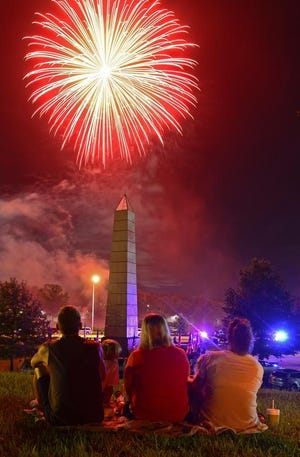Since 1777, the United States has celebrated Independence Day on July 4, signifying the anniversary of the signing of the Declaration of Independence. Congress passed legislation on June 28, 1870, making it an official national holiday.
Today, the date is associated with family cookouts and community-wide celebrations. However, many Fourth of July traditions date back as far as that first Independence Day celebration, and they have meaningful backgrounds.
Two of the major ones are fireworks and clothing. Here’s what they mean in America’s birthday celebration.
Time to celebrate:Here’s where you can see fireworks on Fourth of July weekend in Etowah County area
Going out on the boat?:ALEA issues boating safety tips ahead of Fourth of July weekend
Fireworks
Originally invented by the Tang Dynasty in 900 A.D., modern fireworks weren’t created until around 1830. Until then, fireworks would only shoot off a “fire color” until other colors were introduced using various minerals such as copper and sodium.

Fireworks became a part of America’s Independence Day during the first celebration on July 4, 1777, in Philadelphia. A ship docked in the harbor fired off 13 shots from a cannon, signifying each of the 13 original colonies, and 13 fireworks were set off in the city’s commons, and also in Boston.
This idea was originated by John Adams, who wrote to his wife two days prior to the signing of the Declaration of Independence about how he’d like this day to be celebrated.
“This day will be most memorable in the history of America,” he predicted. “I am apt to believe that it will be celebrated by succeeding generations as the great anniversary festival… It ought to be solemnized with pomp and parade… bonfires and illuminations [fireworks] … from one end of this content to the other, from this time forward forevermore.”
Since then, fireworks have been cemented into the celebration of Independence Day, making it the holiday’s oldest tradition.
Wearing the Red, White and Blue
Because many associate the Fourth of July as a time to remember and proclaim their patriotism, people will often be seen proudly wearing the colors of the American flag (as they do on other holidays such as Memorial Day and Veterans Day).
The first rendition of the American flag came on June 14, 1777, with Congress voting on a resolution for the design, saying, “Resolved, that the flag of the United States be thirteen stripes, alternate red and white; that the union be thirteen stars, white in a blue field, representing a new constellation.”
The flag has had many variants over the country’s history, with the design we see today dating back to 1960, after the addition of Alaska and Hawaii as states.
The present design has several ties back to the original flag, with 13 stripes to signify the 13 colonies and 50 stars to signify every state in the country.
Read this:Traveling for July Fourth? Here are 5 things to know before flying, driving this weekend.
From USA TODAY:Fourth of July movies: What to watch this weekend, from the new ‘Minions’ to ‘The Forgiven’
However, there is not much discussion as to why the colors of the flag were originally chosen, though historians have their theories.
“Our heritage does come from Great Britain, and that was some of the thought process that went about in coming up with our flag,” Mike Buss, a flag expert with the American Legion, says of the American flag’s red, white and blue. “They come from the three colors that the Founding Fathers had served under or had been exposed to.”
Even so, the colors still hold a significant amount of meaning. While red symbolizes hardiness and valor, white symbolizes purity and innocence. As for the blue, it represents vigilance, perseverance and justice.
As a result of the colors and what they signify, it isn’t uncommon to see them being worn by people across the country, especially on days like Independence Day.

